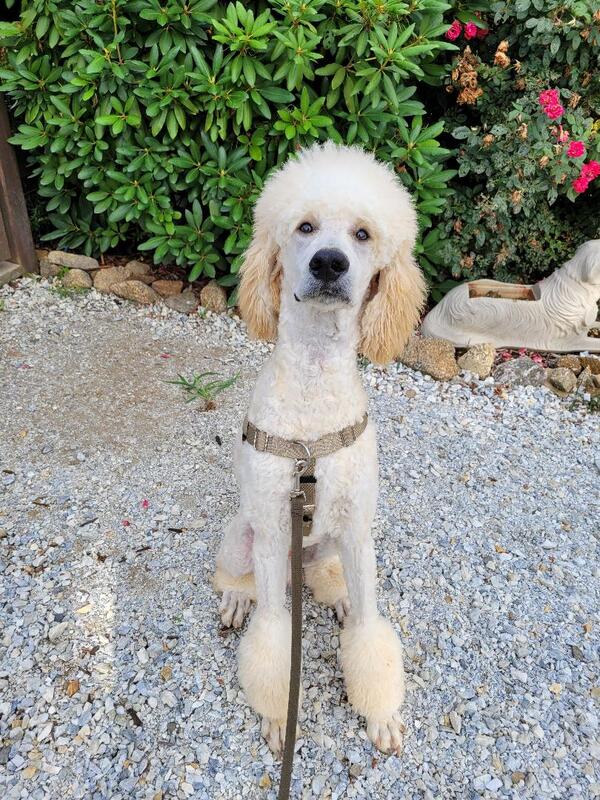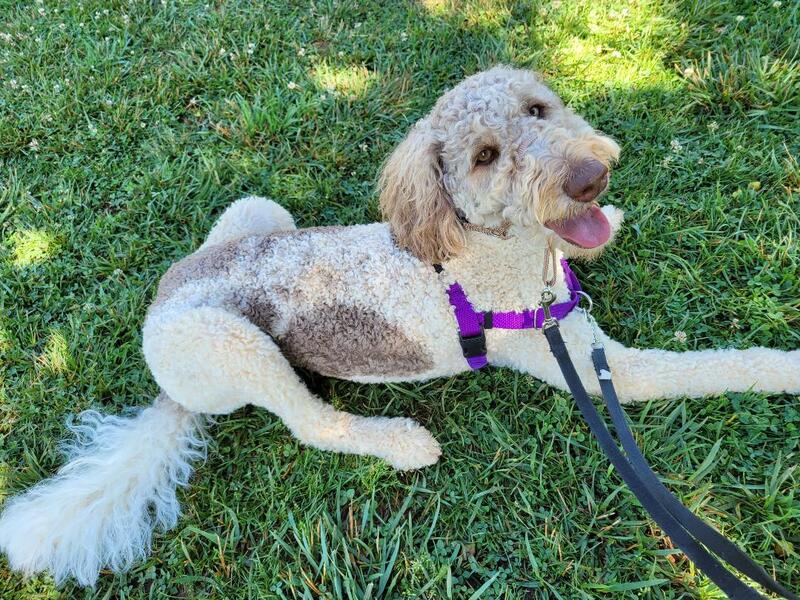Poodles are ranked as one of the most intelligent breeds on behavior scales and in the top ten of most registered breeds with the American Kennel Club for decades. As perfect as they are as purebred dogs, they are also the most popular breed of dog to mix with numerous other breeds, creating Designer Dogs that can cost thousands of dollars.
What is it about Poodles that makes them the ideal breed for this purpose?
Throughout history, they have been the foundation of many purebred dogs who are registered in world-wide kennel clubs. From Portuguese Water Dogs to the Curley Coated Retriever, you can instantly recognize many of the Poodles’ influences just by appearance – the curly coat.
Appearances, however, have only a minor role in the creation of these breeds. Poodles were chosen as foundation dogs for their intelligence and versatility, as well.
What is it about Poodles that makes them the ideal breed for this purpose?
Throughout history, they have been the foundation of many purebred dogs who are registered in world-wide kennel clubs. From Portuguese Water Dogs to the Curley Coated Retriever, you can instantly recognize many of the Poodles’ influences just by appearance – the curly coat.
Appearances, however, have only a minor role in the creation of these breeds. Poodles were chosen as foundation dogs for their intelligence and versatility, as well.
Poodle Personality and Varieties
Poodles have high intelligence, versatility, and hypoallergenic, non-shedding coats. They are easy to train and fit into most family environments. Furthermore, they come in 4 different sizes to please a large array of preferences. Poodles also have a longer life span than most other breeds; especially toy sized breeds.
There are three Poodle attributes that really stand out when considering them as a foundation for a hybrid Doodle Dog - size, coat color and trainability.
Size Variety - Poodles come in 3 recognized sizes (and one that isn't recognized by the AKC) : Standard, Miniature, and Toy.
- The Standard Poodles are typically taller than 15 inches at the shoulder.
- The Miniature Poodle poodles are measure between 11 – 14 inches at the shoulder.
- The Toy Poodle variety is shorter than 10 inches at the shoulder.
- Teacup Poodles (not a recognized AKC breed) can weigh as few as 4 pounds at maturity.
Poodles have a wide variety of coat colors, from black to white and everything in between, including parti-colored (multiple colors).
Poodles are one of the few dogs who shed very little. They don’t have an undercoat, or long, course overcoat. In fact, their coats are considered hair, not typical dog fur. As with hair, a few strands may come out here and there, but not in the large amounts of most dogs. As their hair is very tightly woven, much of the hair that is shed doesn’t leave the dog. This is the reason they require regular professional grooming and brushing.
Besides appearances, there’s also personality and instinctual tendencies that make Poodles an ideal foundation parent for a Doodle Dog. They are great with people of all ages, other dogs, other pets and most environmental situations. In a cold climate, you can allow the coats to grow long. In a warm environment, you need only trim them shorter. Compared to many other purebred dogs, they have relatively few genetic health concerns, enhancing the vitality of their offspring.
And, most importantly, they are highly trainable, making them perfect for a wide variety of jobs.
Poodles are one of the few dogs who shed very little. They don’t have an undercoat, or long, course overcoat. In fact, their coats are considered hair, not typical dog fur. As with hair, a few strands may come out here and there, but not in the large amounts of most dogs. As their hair is very tightly woven, much of the hair that is shed doesn’t leave the dog. This is the reason they require regular professional grooming and brushing.
Besides appearances, there’s also personality and instinctual tendencies that make Poodles an ideal foundation parent for a Doodle Dog. They are great with people of all ages, other dogs, other pets and most environmental situations. In a cold climate, you can allow the coats to grow long. In a warm environment, you need only trim them shorter. Compared to many other purebred dogs, they have relatively few genetic health concerns, enhancing the vitality of their offspring.
And, most importantly, they are highly trainable, making them perfect for a wide variety of jobs.
Poodle Origins
Poodles have been an object of desire for over a thousand years. They're depicted in ancient Roman art dating hundreds of years before the common era. Their history can be traced back beyond their arrival in Europe via the Goths and Ostrogoths, from what is now Russia and Asia, where they were used for herding livestock.
In 15th century they became a recognized breed in Germany, used for retrieving waterfowl. They were called pudelhund, or “dog that splashes about.” Poodles are still popular in Europe as hunting companions for waterfowl sport hunting, retrieving downed game from lakes and other waterways.
In France Poodles were called, caniche, which is a French word for female duck (cane). The larger variety Poodles were similarly utilized in France for waterfowl retrieval. The French then created the size varieties we currently enjoy, with the Standard Poodles remaining the working dogs and the smaller varieties becoming Circus performers, farmer’s helpers, truffle hunters and, in royal courts, lap dogs.
Over the centuries Poodles were mixed with other breeds to enhance their capabilities for specific jobs. For example, the truffle hunting Poodle had been mixed with terriers to make them more tenacious in their hunt. Others were further specialized into what are now purebred dogs, such as Portuguese Water Dogs (the ultimate water dog and retriever), Curly Coated Retrievers, and many more. Whenever a breed was created to aid in the hunt, from ducks to truffles, Poodles were often the foundation parent.
Once Poodles were brought to England, it didn't take long for them to be a recognized breed. Only 3 years from their introduction in 1884 to a breed at the Kennel Club of England in 1887. The American Kennel Club recognized them as a breed that same year, using the English conformation standards as a cornerstone of their own requirement. Poodles were not highly popular, however, until they caught the fancy of wealthy families. And, the frau frau Poodle fad was born.
Poodles have been one of the most frequent Best in Show winners at Westminster and Crufts since 1907. And, their popularity continues to remain consistent around the world.
Poodles didn't only win the beauty contests, but also as guide dogs, guard dogs and wagon pullers. Due to their high energy and intelligence, Poodles were put into service during World Wars I and II, in the field to help move supplies, carry communications and sniff out land mines. Their coats were their own worst enemies in this setting, though, as it's tough to find a groomer in war zones.
It was after World War II when Poodles became status symbols. Wealthy families flouted their well-groomed pets, often wearing jewel encrusted collars. In the 1960s Poodle registrations were very high, showing them to be the most popular dog breed in the United States. They continue to be one of the top 10 most popular American Kennel Club breeds.
Poodles have been an object of desire for over a thousand years. They're depicted in ancient Roman art dating hundreds of years before the common era. Their history can be traced back beyond their arrival in Europe via the Goths and Ostrogoths, from what is now Russia and Asia, where they were used for herding livestock.
In 15th century they became a recognized breed in Germany, used for retrieving waterfowl. They were called pudelhund, or “dog that splashes about.” Poodles are still popular in Europe as hunting companions for waterfowl sport hunting, retrieving downed game from lakes and other waterways.
In France Poodles were called, caniche, which is a French word for female duck (cane). The larger variety Poodles were similarly utilized in France for waterfowl retrieval. The French then created the size varieties we currently enjoy, with the Standard Poodles remaining the working dogs and the smaller varieties becoming Circus performers, farmer’s helpers, truffle hunters and, in royal courts, lap dogs.
Over the centuries Poodles were mixed with other breeds to enhance their capabilities for specific jobs. For example, the truffle hunting Poodle had been mixed with terriers to make them more tenacious in their hunt. Others were further specialized into what are now purebred dogs, such as Portuguese Water Dogs (the ultimate water dog and retriever), Curly Coated Retrievers, and many more. Whenever a breed was created to aid in the hunt, from ducks to truffles, Poodles were often the foundation parent.
Once Poodles were brought to England, it didn't take long for them to be a recognized breed. Only 3 years from their introduction in 1884 to a breed at the Kennel Club of England in 1887. The American Kennel Club recognized them as a breed that same year, using the English conformation standards as a cornerstone of their own requirement. Poodles were not highly popular, however, until they caught the fancy of wealthy families. And, the frau frau Poodle fad was born.
Poodles have been one of the most frequent Best in Show winners at Westminster and Crufts since 1907. And, their popularity continues to remain consistent around the world.
Poodles didn't only win the beauty contests, but also as guide dogs, guard dogs and wagon pullers. Due to their high energy and intelligence, Poodles were put into service during World Wars I and II, in the field to help move supplies, carry communications and sniff out land mines. Their coats were their own worst enemies in this setting, though, as it's tough to find a groomer in war zones.
It was after World War II when Poodles became status symbols. Wealthy families flouted their well-groomed pets, often wearing jewel encrusted collars. In the 1960s Poodle registrations were very high, showing them to be the most popular dog breed in the United States. They continue to be one of the top 10 most popular American Kennel Club breeds.

A Poodle for All Seasons
The three Poodle varieties recognized by the American Kennel Club were originally created for specific jobs. Their vocations cover the spectrum of helping their hunter partners
Poodles were bred for long hours of hard work and need a job in order to remain manageable. They have the ability to reason through problems and have a great ability to remember every life experience. Though social with other dogs they can be a bit aloof, or reserved, when meeting new people. It doesn't take them long to warm up, though.
Sizes Vs. Lifestyles
When choosing a Poodle for your family be sure to take into consideration the personality differences and exercise needs of the different varieties.
***Standard Poodles retain more of their original hunting partner roots. They are high energy and not afraid to get dirty. They love to run, making them perfect for on the go teenagers, young adults or someone with an active lifestyle. They are not fond of loud, sudden noises or lots of commotion, though, and must receive appropriate exposure while pups. Providing an area inside your home for your Poodle to escape commotion will greatly enhance your relationship.
***The Miniature and Toy Poodle varieties tend to do best in households that are not overly noisy or permissive. Many pet parents of these smaller varieties tend to treat them like royalty. Don't fall for it! They're still dogs and need to receive training and guidance just like their larger cousins. Due to their high intelligence, if they live a permissive lifestyle, they can easily become very demanding.
Health Issues
Poodles haven't changed much over the centuries, and tend to be a very healthy breed overall. They do have some common health concerns, however, and you should be aware of them.
***Ear infections. This can happen to any dog with a fold over ear and dog hair within that traps dirt and wax, creating the perfect environment for infections to develop. Keeping the ears free of hair and dirt will easily prevent this from happening.
***Addison’s Disease
***Epilepsy
***Gastric Dilation (a twisting of the stomach, sometimes termed as bloat)
***Tracheal collapse (avoid pulling on a neck collar!)
***Thyroid issues can occur within any of the breed varieties
To understand your Doodle Dog, you must understand the Poodle; their personality, health, appearance and mental capacities. Granted, when you mix these attributes with another dog breed you will likely experience a wholly new individual, but he will still have all his Poodle-ness within and it will appear at one point or another throughout his lifetime.
The three Poodle varieties recognized by the American Kennel Club were originally created for specific jobs. Their vocations cover the spectrum of helping their hunter partners
- Standard Poodles retrieve downed waterfowl from waterways.
- Miniature Poodles flush and retrieve ground birds in the uplands.
- Toy Poodles flush birds and other small game from thick underbrush.
- They share a square build, with equally proportioned legs to body with the length of body from the breastbone to the point of the rump, equal to the height from the highest point of the shoulders to the ground. A well bred Poodle should be square, not elongated with a long back and short legs. Their dark, oval eyes radiate intelligence. Their silky ears tend to fold over near their head and set at, or slightly below, eye level. Then there's the obvious characteristics that make them the perfect foundation parent for Doodles - their curly, dense coat.
Poodles were bred for long hours of hard work and need a job in order to remain manageable. They have the ability to reason through problems and have a great ability to remember every life experience. Though social with other dogs they can be a bit aloof, or reserved, when meeting new people. It doesn't take them long to warm up, though.
Sizes Vs. Lifestyles
When choosing a Poodle for your family be sure to take into consideration the personality differences and exercise needs of the different varieties.
***Standard Poodles retain more of their original hunting partner roots. They are high energy and not afraid to get dirty. They love to run, making them perfect for on the go teenagers, young adults or someone with an active lifestyle. They are not fond of loud, sudden noises or lots of commotion, though, and must receive appropriate exposure while pups. Providing an area inside your home for your Poodle to escape commotion will greatly enhance your relationship.
***The Miniature and Toy Poodle varieties tend to do best in households that are not overly noisy or permissive. Many pet parents of these smaller varieties tend to treat them like royalty. Don't fall for it! They're still dogs and need to receive training and guidance just like their larger cousins. Due to their high intelligence, if they live a permissive lifestyle, they can easily become very demanding.
Health Issues
Poodles haven't changed much over the centuries, and tend to be a very healthy breed overall. They do have some common health concerns, however, and you should be aware of them.
***Ear infections. This can happen to any dog with a fold over ear and dog hair within that traps dirt and wax, creating the perfect environment for infections to develop. Keeping the ears free of hair and dirt will easily prevent this from happening.
***Addison’s Disease
***Epilepsy
***Gastric Dilation (a twisting of the stomach, sometimes termed as bloat)
***Tracheal collapse (avoid pulling on a neck collar!)
***Thyroid issues can occur within any of the breed varieties
To understand your Doodle Dog, you must understand the Poodle; their personality, health, appearance and mental capacities. Granted, when you mix these attributes with another dog breed you will likely experience a wholly new individual, but he will still have all his Poodle-ness within and it will appear at one point or another throughout his lifetime.







